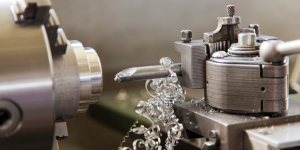CNC milling can process a variety of materials. They are typically producing metal, plastic wood, and composite items of high precision and detail. In computer-controlled operations, machines shave material from a workpiece to shape and size it. Metal CNC milling uses cutting, drilling, and shaping. It can be used to produce plastic prototypes and other manufacturing items. Elaborate wood designs and furniture parts are carved using CNC milling. CNC milling also deals with composite materials where their advantages are merged to achieve desired qualities. In general, CNC milling provides a variety of material choices.
1. What is CNC milling?
CNC milling involves material removal from a workpiece using computer-controlled machines. It uses a revolving cutting tool and some instructions to form complex shapes and designs. CNC milling is used in the aerospace, automotive, and manufacturing industries. computer software that is created from a CAD model controls the milling machine. This allows for precise milling and good-quality products. CNC milling is quicker, more precise and can produce complex parts. With technological breakthroughs, CNC milling has revolutionized the production process in many applications as it gives efficient and cheap solutions.
2. CNC milling with metals:
Metal CNC milling achieves precision and efficiency. Such machines are controlled by computers and in turn, remove material from a workpiece to create complex forms and designs. The beginning of the procedure is to select aluminum, steel, or titanium. The workpiece is clamped onto the milling machine and the cutting tool is positioned to start milling. Fast-feed carbide end mills remove material from the workpiece. What we get is detailed, accurate parts. CNC milling is used in the aerospace, automotive, and medical industries. It can construct intricate geometries and is accurate and consistent. Technological advancements in CNC milling with metals increase manufacturing accuracy and efficiency.

3. CNC milling with plastics:
CNC milling plastics is versatile and efficient working with precision and elaboration possible. Computer-controlled machines form shaped plastic articles by subtractive processes. CNC machining with polymers provides the possibility to make precise complicated forms. Precision cuts made through computer-guided machinery guarantee optimal part fit. Finally, the producers are in a position to select the most suitable material for their application when they mill plastics using CNC. The possible choices include thermoplastics, acrylics, and polycarbonates. CNC milling plastics is affordable for automotive, aerospace, and electronics industries but it can deal with small as well as big production runs.
4. CNC milling with wood:
Precise, elaborate motifs and forms can be created with CNC wood milling. The use of wood with computer-controlled equipment has numerous advantages. First, CNC milling involves accurate cutting to specified dimensions as it’s precise and consistent. This is important because the wood has grain and density variations. CNC milling also enables intricate patterns not possible in traditional woodworking. To create magnificent wooden creations, programming the machine to follow elaborate patterns and curves permits. Creating a tiny decoration or large furniture piece with CNC milling wood is endless creativity and precision.

5. CNC milling with composites:
CNC composite milling is quick and precise. Composites are characterized by high strength-to-weight ratio, corrosion resistance, and good thermal properties. CNC milling is the use of machinery that can be controlled by a computer to create a workpiece material in accordance with specifications. In this approach, it is easy to make elaborate shapes and designs. Composites are heterogeneous and have disparate material properties, so it is hard to CNC machining them. High-quality parts can be produced by addressing these obstacles with the appropriate tools, tactics, and experience. CNC milling composites are revolutionizing manufacturing in aerospace, automotive, and other sectors.
Conclusion
CNC milling is a high-precision procedure of machining metals, polymers, wood, and composites. It can accommodate intricate shapes, fine details, and smooth finishes. CNC milling aids in making quality components in such fields as aerospace, automotive, consumer products, and woodworking. Material processing options will become wider as CNC milling keeps developing alongside technological advancements.
